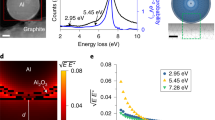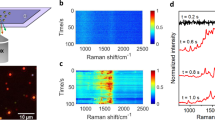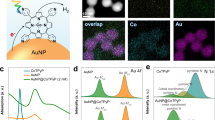Abstract
Recent reports of hot-electron-induced dissociation of small molecules, such as hydrogen, demonstrate the potential application of plasmonic nanostructures for harvesting light to initiate catalytic reactions. Theories have assumed that plasmonic catalysis is mediated by the energy transfer from nanoparticles to adsorbed molecules during the dephasing of localized surface plasmon (LSP) modes optically excited on plasmonic nanoparticles. However, LSP-induced chemical processes have not been resolved at a sub-nanoparticle scale to identify the active sites responsible for the energy transfer. Here, we exploit the LSP resonance excited by electron beam on gold nanoparticles to drive CO disproportionation at room temperature in an environmental scanning transmission electron microscope. Using in situ electron energy-loss spectroscopy with a combination of density functional theory and electromagnetic boundary element method calculations, we show at the subparticle level that the active sites on gold nanoparticles are where preferred gas adsorption sites and the locations of maximum LSP electric field amplitude (resonance antinodes) superimpose. Our findings provide insight into plasmonic catalysis and will be valuable in designing plasmonic antennas for low-temperature catalytic processes.
This is a preview of subscription content, access via your institution
Access options
Access Nature and 54 other Nature Portfolio journals
Get Nature+, our best-value online-access subscription
$29.99 / 30 days
cancel any time
Subscribe to this journal
Receive 12 print issues and online access
$259.00 per year
only $21.58 per issue
Buy this article
- Purchase on Springer Link
- Instant access to full article PDF
Prices may be subject to local taxes which are calculated during checkout





Similar content being viewed by others
Data availability
All relevant data are available from the corresponding author upon request.
References
Mukherjee, S. et al. Hot electrons do the impossible: plasmon-induced dissociation of H2 on Au. Nano Lett. 13, 240–247 (2013).
Zhou, L. et al. Aluminum nanocrystals as a plasmonic photocatalyst for hydrogen dissociation. Nano Lett. 16, 1478–1484 (2016).
Christopher, P., Xin, H. & Linic, S. Visible-light-enhanced catalytic oxidation reactions on plasmonic silver nanostructures. Nat. Chem. 3, 467–472 (2011).
Hartland, G. V., Besteiro, L. V., Johns, P. & Govorov, A. O. What’s so hot about electrons in metal nanoparticles? ACS Energy Lett. 2, 1641–1653 (2017).
Linic, S., Aslam, U., Boerigter, C. & Morabito, M. Photochemical transformations on plasmonic metal nanoparticles. Nat. Mater. 14, 567–576 (2015).
Kale, M. J., Avanesian, T. & Christopher, P. Direct photocatalysis by plasmonic nanostructures. ACS Catal. 4, 116–128 (2013).
Colliex, C., Kociak, M. & Stephan, O. Electron energy loss spectroscopy imaging of surface plasmons at the nanometer scale. Ultramicroscopy 162, A1–A24 (2016).
Schmidt, F. P., Ditlbacher, H., Hofer, F., Krenn, J. R. & Hohenester, U. Morphing a plasmonic nanodisk into a nanotriangle. Nano Lett. 14, 4810–4815 (2014).
Nicoletti, O. et al. Three-dimensional imaging of localized surface plasmon resonances of metal nanoparticles. Nature 502, 80–84 (2013).
Lanzani, G., Nasibulin, A. G., Laasonen, K. & Kauppinen, E. I. CO dissociation and CO+O reactions on a nanosized iron cluster. Nano Res. 2, 660–670 (2009).
Vedyagin, A. A., Mishakov, I. V. & Tsyrulnikov, P. G. The features of the CO disproportionation reaction over iron-containing catalysts prepared by different methods. React. Kinet. Mech. Catal. 117, 35–46 (2015).
Sharma, R. An environmental transmission electron microscope for in situ synthesis and characterization of nanomaterials. J. Mater. Res. 20, 1695–1707 (2005).
Egerton, R. F. Limits to the spatial, energy and momentum resolution of electron energy-loss spectroscopy. Ultramicroscopy 107, 575–586 (2007).
Lopez, N. et al. On the origin of the catalytic activity of gold nanoparticles for low-temperature CO oxidation. J. Catal. 223, 232–235 (2004).
Hohenester, U. Simulating electron energy loss spectroscopy with the MNPBEM toolbox. Comput. Phys. Commun. 185, 1177–1187 (2014).
Hohenester, U., Ditlbacher, H. & Krenn, J. R. Electron-energy-loss spectra of plasmonic nanoparticles. Phys. Rev. Lett. 103, 106801 (2009).
Garcia de Abajo, F. J. & Kociak, M. Probing the photonic local density of states with electron energy loss spectroscopy. Phys. Rev. Lett. 100, 106804 (2008).
Crozier, P. A. Vibrational and valence aloof beam EELS: a potential tool for nondestructive characterization of nanoparticle surfaces. Ultramicroscopy 180, 104–114 (2017).
Losquin, A. & Kociak, M. Link between cathodoluminescence and electron energy loss spectroscopy and the radiative and full electromagnetic local density of states. ACS Photon. 2, 1619–1627 (2015).
Boudarham, G. & Kociak, M. Modal decompositions of the local electromagnetic density of states and spatially resolved electron energy loss probability in terms of geometric modes. Phys. Rev. B 85, 245447 (2012).
Hartshorn, H., Pursell, C. J. & Chandler, B. D. Adsorption of CO on supported gold nanoparticle catalysts: a comparative study. J. Phys. Chem. C 113, 10718–10725 (2009).
Chenna, S. & Crozier, P. A. Operando transmission electron microscopy: a technique for detection of catalysis using electron energy-loss spectroscopy in the transmission electron microscope. ACS Catal. 2, 2395–2402 (2012).
Garvie, L. A. J., Craven, A. J. & Brydson, R. Use of electron-energy-loss near-edge fine-structure in the study of minerals. Am. Mineral 79, 411–425 (1994).
Green, I. X., Tang, W. J., Neurock, M. & Yates, J. T. Spectroscopic observation of dual catalytic sites during oxidation of CO on a Au/TiO2 catalyst. Science 333, 736–739 (2011).
Boerigter, C., Campana, R., Morabito, M. & Linic, S. Evidence and implications of direct charge excitation as the dominant mechanism in plasmon-mediated photocatalysis. Nat. Commun. 7, 10545 (2016).
Boerigter, C., Aslam, U. & Linic, S. Mechanism of charge transfer from plasmonic nanostructures to chemically attached materials. ACS Nano 10, 6108–6115 (2016).
Aslam, U., Chavez, S. & Linic, S. Controlling energy flow in multimetallic nanostructures for plasmonic catalysis. Nat. Nanotechnol. 12, 1000–1005 (2017).
Chavez, S., Aslam, U. & Linic, S. Design principles for directing energy and energetic charge flow in multicomponent plasmonic nanostructures. ACS Energy Lett. 3, 1590–1596 (2018).
Brongersma, M. L., Halas, N. J. & Nordlander, P. Plasmon-induced hot carrier science and technology. Nat. Nanotechnol. 10, 25–34 (2015).
Brown, A. M., Sundararaman, R., Narang, P., Goddard, W. A.III. & Atwater, H. A. Nonradiative plasmon decay and hot carrier dynamics: effects of phonons, surfaces, and geometry. ACS Nano 10, 957–966 (2016).
Foerster, B. et al. Chemical interface damping depends on electrons reaching the surface. ACS Nano 11, 2886–2893 (2017).
Wu, K., Chen, J., McBride, J. R. & Lian, T. Efficient hot-electron transfer by a plasmon-induced interfacial charge-transfer transition. Science 349, 632–635 (2015).
Swearer, D. F. et al. Heterometallic antenna-reactor complexes for photocatalysis. Proc. Natl Acad. Sci. USA 113, 8916–8920 (2016).
Giannozzi, P. et al. Quantum espresso: a modular and open-source software project for quantum simulations of materials. J. Phys. Condens. Matter 21, 395502 (2009).
Perdew, J. P., Burke, K. & Ernzerhof, M. Generalized gradient approximation made simple. Phys. Rev. Lett. 77, 3865–3868 (1996).
Blöchl, P. E. Projector augmented-wave method. Phys. Rev. B 50, 17953–17979 (1994).
Jiang, D. E. & Carter, E. A. Adsorption and dissociation of CO on Fe(110) from first principles. Surf. Sci. 570, 167–177 (2004).
Sau, T. K. & Murphy, C. J. Room temperature, high-yield synthesis of multiple shapes of gold nanoparticles in aqueous solution. J. Am. Chem. Soc. 126, 8648–8649 (2004).
Hohenester, U. & Trügler, A. MNPBEM—a Matlab toolbox for the simulation of plasmonic nanoparticles. Comput. Phys. Commun. 183, 370–381 (2012).
Acknowledgements
The authors thank R. Egerton (University of Alberta), P. Batson (Rutgers University), U. Hohenester (Karl-Franzens-Universität Graz), P. Longo (Gatan), Q. Qiao (Temple University), J. Kohoutek (NIST) and A. Herzing (NIST) for useful discussions. W.D.Y., P.A.L. and C.W. acknowledge support under the Cooperative Research Agreement between the University of Maryland and the National Institute of Standards and Technology Physical Measurement Laboratory, award 70NANB14H209, through the University of Maryland.
Author information
Authors and Affiliations
Contributions
W.D.Y., C.W., P.A.L., and R.S. conceived and designed the research. W.D.Y. and P.A.L. fabricated the gold antennas. W.D.Y. conducted in situ measurements in the ESTEM and processed the data. W.D.Y. and P.A.L. determined the crystallographic structure of the gold antennas. L.A.F. carried out DFT calculations. W.D.Y., L.S. and H.J.L. carried out electromagnetic BEM calculations. All authors contributed to writing the manuscript.
Corresponding author
Ethics declarations
Competing interests
The authors declare no competing interests.
Additional information
Publisher’s note: Springer Nature remains neutral with regard to jurisdictional claims in published maps and institutional affiliations.
Supplementary information
Supplementary Information
Supplementary Figs. 1–12, Supplementary Tables 1,2, Supplementary refs. 1–15
Rights and permissions
About this article
Cite this article
Yang, WC.D., Wang, C., Fredin, L.A. et al. Site-selective CO disproportionation mediated by localized surface plasmon resonance excited by electron beam. Nat. Mater. 18, 614–619 (2019). https://doi.org/10.1038/s41563-019-0342-3
Received:
Accepted:
Published:
Issue Date:
DOI: https://doi.org/10.1038/s41563-019-0342-3
This article is cited by
-
Direct observation of the plasmon-enhanced palladium catalysis with single-molecule fluorescence microscopy
Nano Research (2023)
-
Endothermic reaction at room temperature enabled by deep-ultraviolet plasmons
Nature Materials (2021)



